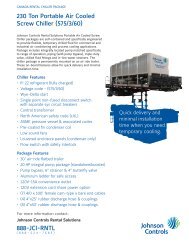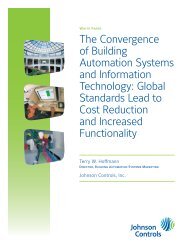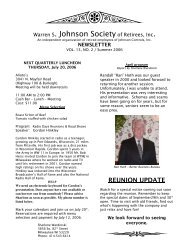Rxf - Johnson Controls Inc.
Rxf - Johnson Controls Inc.
Rxf - Johnson Controls Inc.
Create successful ePaper yourself
Turn your PDF publications into a flip-book with our unique Google optimized e-Paper software.
Drilling can cause metal filings to land on the electronics and<br />
create a short circuit when powered is applied. If you must<br />
drill the panel, take the following precautions:<br />
• First, call the panel manufacturer before drilling into the<br />
panel to be sure you are entering the panel at the right<br />
place.<br />
• Take measures to avoid ESD (electrostatic discharge) to the<br />
electronics as you prep the inside of the Electronic control<br />
panel. This can be done by employing an antistatic wrist<br />
band and mat connected to ground.<br />
• Cover the electronics with plastic and secure it with<br />
masking or electrical tape.<br />
• Place masking tape or duct tape on the inside of the panel<br />
where you are going to drill. The tape will catch most of<br />
the filings.<br />
• Clean all of the remaining filings from the panel before<br />
removing the protective plastic.<br />
When routing conduit to the top of an electronic control<br />
panel, condensation must be taken into consideration. Water<br />
can condense in the conduit and run into the panel causing<br />
catastrophic failure. Route the conduit to the sides or bottom<br />
of the panel and use a conduit drain. If the conduit must be<br />
routed to the top of the panel, use a sealable conduit fitting<br />
which is poured with a sealer after the wires have been<br />
pulled, terminated, and the control functions have been<br />
checked. A conduit entering the top of the enclosure must<br />
have a NEMA-4 hub type fitting between the conduit and<br />
the enclosure so that if water gets on top of the enclosure<br />
it cannot run in between the conduit and the enclosure. This<br />
is extremely important in outdoor applications.<br />
NOTE: It is simply NEVER a good practice to enter through<br />
the top of an electronic control panel or starter panel that<br />
does not already have knockouts provided. If knockouts<br />
are not provided for this purpose it is obvious this is not<br />
recommended and could VOID WARRANTY.<br />
Never add relays, starters, timers, transformers, etc. inside<br />
an electronic control panel without first contacting<br />
the manufacturer. Contact arcing and EMI emitted from<br />
these devices can interfere with the electronics. Relays and<br />
timers are routinely added to electronic control panels by the<br />
manufacturer, but the manufacturer knows the acceptable<br />
device types and proper placement in the panel that will<br />
keep interference to a minimum. If you need to add these<br />
devices, contact the manufacturer for the proper device<br />
types and placement.<br />
Never run refrigerant tubing inside an electronic control<br />
panel. If the refrigerant is ammonia, a leak will totally destroy<br />
the electronics.<br />
If the electronic control panel has a starter built into the<br />
same panel, be sure to run the higher voltage wires where<br />
indicated by the manufacturer. EMI from the wires can<br />
interfere with the electronics if run too close to the circuitry.<br />
RXF ROTARY SCREW COMPRESSOR UNITS<br />
PROPER INSTALLATION OF ELECTRICAL EQUIPMENT<br />
070.410-IOM (JUL 11)<br />
Page 51<br />
Never daisy-chain or parallel-connect power or ground<br />
wires to electronic control panels. Each electronic control<br />
panel must have its own control power supply and ground<br />
wires back to the power source (Plant Transformer). Multiple<br />
electronic control panels on the same power wires create<br />
current surges in the supply wires, which may cause controller<br />
malfunctions. Daisy-chaining ground wires, taking them<br />
to ground at each device, allows ground loop currents to<br />
flow between electronic control panels which also causes<br />
malfunctions. See Figure 41.<br />
Figure 41










![[PDF] Intelligent Fire Annunciator IFA-1000 - Johnson Controls Inc.](https://img.yumpu.com/7424420/1/190x245/pdf-intelligent-fire-annunciator-ifa-1000-johnson-controls-inc.jpg?quality=85)





